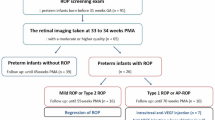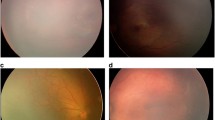Abstract
Purpose
To describe the characteristics and clinical course of retinopathy of prematurity (ROP)-like ridges in healthy full-term newborns.
Methods
A retrospective medical record review was performed on newborns who underwent fundus photography within 72 h of birth between January 1st and December 31st, 2019 at Women & Children's Health Care Hospital of Huantai, China. The RetCam 3 wide-field digital imaging system was used for fundus photography. ROP-like ridges were discovered and described.
Results
Total of 5507 full-term infants underwent fundus photography. ROP-like ridges were discovered in 90 eyes from 57 infants (1.0%). Stage 1 ROP-like was seen in 63 of the eyes (70%), Stage 2 ROP-like in 26 of the eyes (28.9%), and Stage 3 ROP-like in 1 eye (1.1%). These ROP-like ridges were found in Zone II (41.1%) and Zone III (58.9%), but not in Zone I. Eight (8.9%) of the eyes had pre-plus-like diseases. No eyes had plus disease. All ROP-like ridges and pre-plus-like diseases were spontaneously regressed with a mean duration of 39.0 ± 8.2 days. Male sex (P = 0.003) was positively associated with ROP-like changes.
Conclusion
Healthy full-term newborns may have incomplete retinal vascularization and ROP-like ridges at birth. These ROP-like ridges showed signs of spontaneous regression.

Similar content being viewed by others
References
Vinekar A, Govindaraj I, Jayadev C et al (2015) Universal ocular screening of 1021 term infants using wide-field digital imaging in a single public hospital in India - a pilot study. Acta Ophthalmol 93:e372–e376. https://doi.org/10.1111/aos.12685
Li LH, Li N, Zhao JY et al (2013) Findings of perinatal ocular examination performed on 3573, healthy full-term newborns. Br J Ophthalmol 97:588–591. https://doi.org/10.1136/bjophthalmol-2012-302539
Fei P, Liu Z, He L et al (2020) Early detection of ocular abnormalities in a Chinese multicentre neonatal eye screening programme-1-year result. Acta Ophthalmol 99(3):e415–e422. https://doi.org/10.1111/aos.14586
Simkin SK, Misra SL, Battin M et al (2019) Prospective observational study of universal newborn eye screening in a hospital and community setting in New Zealand. BMJ Paediatr open 3:1–6. https://doi.org/10.1136/bmjpo-2018-000376
Goyal P, Padhi TR, Das T et al (2018) Outcome of universal newborn eye screening with wide-field digital retinal image acquisition system: a pilot study. Eye 32:67–73. https://doi.org/10.1038/eye.2017.129
International Committee for the Classification of Retinopathy of P (2005) The international classification of retinopathy of prematurity revisited. Arch Ophthalmol 123:991–999. https://doi.org/10.1001/archopht.123.7.991
Selvam S, Kumar T, Fruttiger M (2018) Retinal vasculature development in health and disease. Prog Retin Eye Res 63:1–19. https://doi.org/10.1016/j.preteyeres.2017.11.001
Liu D, Zheng J, Lu Y (2021) Fundus examination of 23,861 newborns by digital imaging in Ningbo. J Ophthalmol 2021:6620412. https://doi.org/10.1155/2021/6620412
Hartnett ME, Penn JS (2012) Mechanisms and management of retinopathy of prematurity. N Engl J Med 367:2515–2526. https://doi.org/10.1056/NEJMra1208129
Kang EY-C, Lien R, Wang N-K et al (2018) Retinopathy of prematurity trends in Taiwan: a 10-year Nationwide population study. Invest Ophthalmol Vis Sci 59:3599–3607. https://doi.org/10.1167/iovs.18-24020
Ludwig CA, Chen TA, Hernandez-Boussard T et al (2017) The epidemiology of retinopathy of prematurity in the United States. Ophthalmic Surg Lasers Imaging Retin 48:553–562. https://doi.org/10.3928/23258160-20170630-06
Li L, Gao Y, Chen W, Han M (2022) Screening for retinopathy of prematurity in North China. BMC Ophthalmol 22(1):1–8. https://doi.org/10.1186/s12886-022-02470-3
Wasilewski D, Zago RJ, Bardal AMC et al (2002) Importance of the ophthalmological evaluation in newborns. J Pediatr (Rio J) 78:209–212
Ratra D, Akhundova L, Das MK (2017) Retinopathy of prematurity like retinopathy in full-term infants. Oman J Ophthalmol 10:167–172. https://doi.org/10.4103/ojo.OJO_141_2016
Wang L, Li M, Zhu J et al (2021) Clinical features of spontaneous regression of retinopathy of prematurity in China: a 5-year retrospective case series. Front Med 8:731421. https://doi.org/10.3389/fmed.2021.731421
Rao F-Q, Cai X-B, Cheng F-F et al (2017) Mutations in LRP5, FZD4, TSPAN12, NDP, ZNF408, or KIF11 genes account for 38.7% of chinese patients with familial exudative vitreoretinopathy. Invest Ophthalmol Vis Sci 58:2623–2629. https://doi.org/10.1167/iovs.16-21324
Funding
National Natural Science Foundation of China (NSFC): Qiujing Huang 81900908. Science and Technology Commission of Shanghai Municipality, Shanghai Sailing Program: Qiujing Huang 19YF1432500. Science and Technology Commission of Shanghai Municipality, Shanghai Sailing Program: Jie Peng 20YF1429700. Science and Technology Bureau of Huantai County: Hua Zhu 2018kj070028. Shanghai Hospital Development Center: Peiquan Zhao SHDC2020CR5014-002. National Natural Science Foundation of China (NSFC): Peiquan Zhao 81770964.
Author information
Authors and Affiliations
Contributions
QH was responsible for the design of the study, the analysis and interpretation of data, drafting and revising the manuscript, and submission of the manuscript. CW was responsible for the design of the study, the acquisition, and analysis of the data, and drafting and revising the manuscript. HY was responsible for the design of the study, the acquisition of the data, and drafting and revising the manuscript. YL was responsible for the design of the study, the acquisition of the data, and drafting and revising the manuscript. HZ was responsible for the design of the study, the acquisition of the data, and drafting and revising the manuscript. JP was responsible for the design of the study, the analysis of the data, and revising the manuscript. JL was responsible for the design of the study, the acquisition of the data, drafting and revising the manuscript, and submission of the manuscript. PZ was responsible for the design of the study, the analysis and interpretation of the data, drafting and revising the manuscript, and submission of the manuscript.
Corresponding authors
Ethics declarations
Conflict of interest
The authors declare that they have no competing interests.
Ethics approval
This study was conducted with Institutional Review Board approval (by the Ethics Committee of Xin Hua Hospital Affiliated to Shanghai Jiao Tong University School of Medicine, Approval No. XHEC-D-2021–083) and adhered to the tenets of the Declaration of Helsinki.
Consent to participate
Before all examinations, a consent form was signed by each infant's parents or legal guardians.
Consent for publication
Not applicable.
Additional information
Publisher's Note
Springer Nature remains neutral with regard to jurisdictional claims in published maps and institutional affiliations.
Rights and permissions
Springer Nature or its licensor (e.g. a society or other partner) holds exclusive rights to this article under a publishing agreement with the author(s) or other rightsholder(s); author self-archiving of the accepted manuscript version of this article is solely governed by the terms of such publishing agreement and applicable law.
About this article
Cite this article
Huang, Q., Wang, C., Yu, H. et al. Incomplete retinal vascularization with retinopathy of prematurity-like ridges in healthy full-term newborns. Int Ophthalmol 43, 3263–3268 (2023). https://doi.org/10.1007/s10792-023-02729-8
Received:
Accepted:
Published:
Issue Date:
DOI: https://doi.org/10.1007/s10792-023-02729-8




